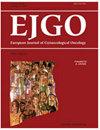Adjuvant radiotherapy of endometrial cancer: role of 18F-FDG-PET/CT in treatment modulation
IF 0.5
4区 医学
Q4 OBSTETRICS & GYNECOLOGY
引用次数: 0
Abstract
Objective : Residual disease after surgery is related to an unfavorable prognosis in patients with endometrial cancer (EC). An early diagnosis and treatment of this condition could improve patients’ outcome. Aim of this study was to define the role of postoperative 18 F-Fluorodeoxyglucose-Positron Emission Tomography/Computed Tomography ( 18 F-FDG-PET/CT) in patients with high risk of residual disease after EC surgery. Methods : Patients operated for EC, with one or more risk factors, who underwent 18 F-FDG-PET/CT before adjuvant treatment were included in this observational study. The primary endpoint was the rate of patients in whom 18 F-FDG-PET/CT changed the treatment strategy and/or the radiotherapy (RT) planning. Results : Our analysis included 58 patients (median age: 67.5 years, range: 48.0–86.0) with the following risk factors: lymphadenectomy not performed (26 patients; 44.8%), inadequate lymphadenectomy (23 patients; 39.7%), and high risk of residual disease due to advanced stage (nine patients; 15.5%). Postoperative 18 F-FDG-PET/CT imaging was positive in 18 patients (31%) in the following sites: pelvic extra-nodal disease (one patient), pelvic and/or paraaortic lymph nodes (12 patients), distant metastases (one patient), or combination of previous sites (four patients). Based on these results, the adjuvant therapeutic strategy was changed in five patients, three of whom were referred to chemotherapy alone due to distant metastases and two of whom were referred to nodal-directed treatment due to lymph node metastases (lymphadenectomy and pelvic chemoradiation plus boost, respectively). Furthermore, based on the 18 F-FDG-PET/CT results, the RT plan was modified in 13 patients (addition of a boost on residual pelvic/abdominal disease in 12 and target modification in one, respectively). Therefore, based on postoperative 18 F-FDG-PET/CT findings, the therapeutic strategy and the RT plan were changed in 5 patients (8.6%) and 13 patients (22.4%), respectively. Conclusion : In this analysis, the adjuvant treatment was modified after post-operative 18 F-FDG-PET/CT in about one third of patients. Further studies are needed to better define the risk factors (or their combinations) correlated with higher probability of residual disease after radical hysterectomy-adnexectomy for EC.癌症辅助放射治疗:18F-FDG-PET/CT在调节治疗中的作用
目的:子宫内膜癌(EC)术后残留病变与预后不良有关。这种情况的早期诊断和治疗可以改善患者的预后。本研究的目的是确定18 f -氟脱氧葡萄糖-正电子发射断层扫描/计算机断层扫描(18 F-FDG-PET/CT)在EC术后残留疾病高风险患者中的作用。方法:在辅助治疗前接受18次F-FDG-PET/CT检查的伴有一种或多种危险因素的EC手术患者纳入本观察性研究。主要终点是18f - fdg - pet /CT改变治疗策略和/或放疗(RT)计划的患者比率。结果:我们的分析纳入了58例患者(中位年龄:67.5岁,范围:48.0-86.0岁),其危险因素如下:未行淋巴结切除术(26例,44.8%),淋巴结切除术不充分(23例,39.7%),晚期残留疾病的高风险(9例,15.5%)。术后18例患者(31%)的F-FDG-PET/CT成像在以下部位呈阳性:盆腔结外疾病(1例)、盆腔和/或主动脉旁淋巴结(12例)、远处转移(1例)或先前部位的合并(4例)。基于这些结果,改变了5例患者的辅助治疗策略,其中3例因远处转移而单独化疗,2例因淋巴结转移而接受淋巴结定向治疗(分别为淋巴结切除术和盆腔放化疗加强化)。此外,根据18例F-FDG-PET/CT结果,对13例患者的RT计划进行了修改(分别增加了12例残留盆腔/腹腔疾病的增强和1例目标修改)。因此,根据术后18例F-FDG-PET/CT表现,分别有5例(8.6%)和13例(22.4%)患者改变了治疗策略和放疗计划。结论:在本分析中,约三分之一的患者在术后18 F-FDG-PET/CT后对辅助治疗进行了修改。需要进一步的研究来更好地确定与根治性子宫-附件切除术后残留疾病较高概率相关的危险因素(或其组合)。
本文章由计算机程序翻译,如有差异,请以英文原文为准。
求助全文
约1分钟内获得全文
求助全文
来源期刊
自引率
25.00%
发文量
58
审稿时长
1 months
期刊介绍:
EJGO is dedicated to publishing editorial articles in the Distinguished Expert Series and original research papers, case reports, letters to the Editor, book reviews, and newsletters. The Journal was founded in 1980 the second gynaecologic oncology hyperspecialization Journal in the world. Its aim is the diffusion of scientific, clinical and practical progress, and knowledge in female neoplastic diseases in an interdisciplinary approach among gynaecologists, oncologists, radiotherapists, surgeons, chemotherapists, pathologists, epidemiologists, and so on.

 求助内容:
求助内容: 应助结果提醒方式:
应助结果提醒方式:


